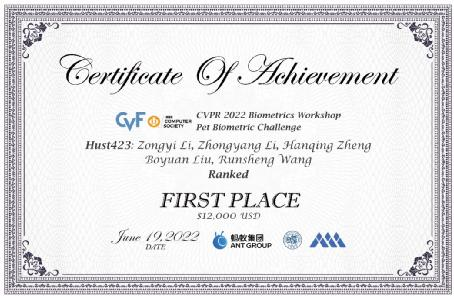Recently, the team of Professor Hefei Lingof the School of Computer Science and Technology, Huazhong University of Science and Technology (HUST)has won the global championship in the CVPR 2022 PetBiometric Challenge.

CVPR, a world-class academic conference in the field of computer vision and pattern recognition held by IEEE, attracts many professionals worldwide to participate every year. It is not only a conference for scholars to display cutting-edge scientific and technological achievements but also a platform for all walks of life to explore academic applications. The CVPR22 Workshop, held by AntGrouptogether with domestic and foreign scientific research institutions "for real scenarios", focuses on the application of academic research to the industry. When facing real problems and challenges in business scenarios, we can promote the use of cutting-edge technologies to solve real problems through the combination of industry and research. The competition aims to encourage technological innovation to solve the identification and authentication problems of dogs in real-life situations. The competition attracted more than 1,300 teams from Tsinghua University, New York University, the Chinese University of Hong Kong, the Chinese Academy of Sciences, Xi'an Jiaotong University, Fudan University, Beihang University, Harbin Institute of Technology, WuhanUniversity, Google, China Telecom, Ping An of China, and so on. In the end, a team from HUST won the championship in these biometric challenges.
Identifying and authenticating pets of the same breed that are so similar in appearance can be a challenging task. To solve this problem, the participating teams innovatively proposed a weighted contrast loss of difficult samples based on instance characteristics. This method can record the features of all the training images and update them online. Each sample needs to find the first N difficult negative samples in the feature pool for comparison loss. At the same time, the positive samples are also weighted according to their similarity, so as to strengthen the learning of difficult positive samples. The weighted contrast loss of difficult samples based on instance characteristics can enhance the degree of differentiation among fine-grained samples. In addition, the team also used data enhancement and multi-model fusion technology to cope with the lighting and angle changes during the shooting process, achieving higher recognition accuracy on real data. After two months of competition and algorithm evaluation such as preliminary and rematch, the team achieved first place in the world in the preliminary rematch, with the final score of AUC 0.91 points, 2 percentage points ahead of the second place.
With the rapid growth of the pet economy, the pet industry empowered by AI technology has gradually become a focus of attention in the industry. For example, pet identity authentication through technical means has important social and economic value in pet management, trading, medical treatment, insurance, and many other application scenarios. This competition aims to solve the identity authentication problem of pet dogs in real situations, and aims to promote the application of artificial intelligence technology in the pet industry and promote the development and progress of the industry. The core of this technology is to achieve fine-grained biometric identification, which can be applied to pets, breeding, animal protection, and other industries on the one hand. On the other hand, it is more widely used in human multidimensional biometric recognition.
The champion team of this competition is from the Visual Computing and Intelligent Cognition Laboratory of the School. The laboratory has been deeply engaged in the field of individual recognition, image retrieval, and artificial intelligence security for a long time. In the past two years, it has won first and second place in many international and domestic competitions.
